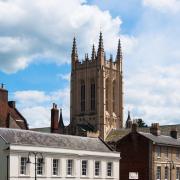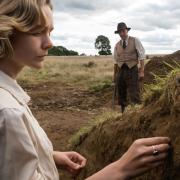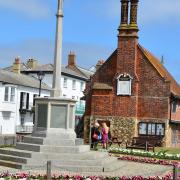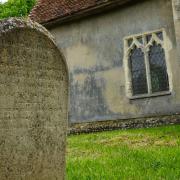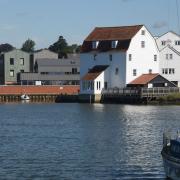The fascinating story of St Edmund the King may be rooted in the west, but as Lindsay Want reveals his legacy is to be found all over the county

Once upon a time (well, in about the 9th century apparently), there was in these here Suffolk parts, a right royal chap called Edmund. Crowned at the tender age of 14, the boy-king turned out to be a bit of lad with an everlasting legacy. But the sainted Edmund has been more than just the talk of one of our main Suffolk towns for centuries: from Kessingland to Kersey and Lakenheath to Little Thurlow, he has found his way onto the lips (and walls and fabric) of communities across the whole county.
His story is everywhere, so it must be a goodie, a mix of all the right ingredients to fascinate folk from medieval times to the present day. There’s murder, mystery, miracles and even an animal in the plot, as he martyrs himself for his faith, is shot through by Danish arrows and decapitated, before his severed skull is finally safeguarded, beard, crown and all, by a strangely benevolent wolf. Ultimately though, the young monarch’s inspiring tale is a distinctly heady mix of hearsay and history, if it’s ever possible to distinguish between the two. One to be handled with kid gloves perhaps?

History, in a roundabout sort of way
Hats off to Bury in Bloom then, whose local partnership has seen Edmund-inspired artworks putting a whole modern day spin on the story. Head into Bury St Edmunds and on the roundabout at Risbygate, the royal murder is given a certain sort of steely beauty, with the king sporting a rather spiffing goaty beard.
There’s the St Edmund/Suffolk insignia of the crown and crossed arrows executed in wonderfully woven wicker-work on the traffic island at Cullum Road, and are those giant arrows planted in the roundabout at King’s Road? Or could they be huge ears of wheat? Perhaps it depends on the season, on what’s on your mind or whether you’ve just come from Southgate, where a haunting, howling wolf catches the eye along with the glint of a king’s crown.

No porkies intended
Best not forget though that Ben Loughrill had digital photography and a pretty nifty chainsaw to hand when he carved Bury’s now iconic and rather life-like wolf statue out of oak. Alas, our ancestors had no such luxuries and even the most skilled painters and carvers had to rely on potentially dodgy memories, imaginations or long-in-the-tooth stories for a likeness.

Pop in to St Mary’s Bury to spot a ‘kindly’ wolf that’s simply all fangs in the Victorian stained glass, or discover the would-be wolf with a gummy grin and undeniably pig-like snout, guarding King Edmund’s head on the carved bench end in Stonham Aspal church.
Images of Edmund himself vary incredibly across the centuries too, from the gentlest, almost effeminate features set to rival an adjacent Virgin Mary in Lakenheath’s early 14th century wall-paintings, to the colourful, lavishly dressed monarch clutching his arrow on Kersey’s 15th century painted screen, or the true grit, be-whiskered face of royal determination that’s carved in stone on St Edmund’s Southwold.

A real place with tales to tell
But isn’t this history all over? Open to interpretation, moving with the times, going round in circles? Head for Hoxne near Diss, pick up a heritage map from the village hall car park for a circular walk and you’ll soon get the gist.
Whether ‘Haegilisdun’ mentioned in the chronicles of yore is really Norfolk’s Hellesdon, Hellesden Ley at Suffolk’s Bradfield St Clare or somewhere else entirely, Hoxne has firmly claimed it for itself. It was here that King Edmund, son of Ealhhere (or maybe Aethelweard or possibly Alkmund of Nuremberg - go on, take your pick!) was captured by Inguar the Boneless and his brother, Ubba, and put to death in 869 (or about then at least!).
Some reports, suspiciously compiled centuries later, detail how enemies tied him to a tree, shot him through with arrows, then to deny him a decent burial, hid his severed head far away in the thicket. In Hoxne there is ‘evidence’ of all this, and more besides.
Hard facts or just a nice bit of fiction?
“Near this spot St Edmund the King was taken prisoner and slain by the Danes AD 870” – Hoxne’s apparent ‘facts’ are set in stone on the village hall and again on the ‘original’ Gold Brook Bridge (… replaced 1878) where Edmund reputedly hid himself from the enemy. Thanks to an enthusiastic Victorian novelist who embellished a local ‘legend’ about a wedding party seeing the reflection of the king’s golden spurs in the water here and betraying him to the foe, brides still avoid crossing the bridge en route to their marriage ceremony in fear of retribution!
Just up the road, more dates set in stone recall an ancient oak which collapsed under its own weight in 1843 - surely the place of Edmund’s martyrdom as metal was found embedded inside it. Oh, and just to confirm things further, the site’s first stone memorial was struck by lightning!
Talking heads
Tales stretching over time tell how the Saint’s severed head cried out to be discovered in the safe-keeping of a local wolf across the Hoxne fields. Or was it the clever wolf doing the talking? Accounts conflict, but either way, it was all rather miraculous with the royal head and body later magically fusing together when reunited and never decomposing.
Could Abbey Farm just across from the martyrdom memorial have been the site of the crude wooden chapel where Edmund’s body lay for a third of a century before being moved to Beodricsworth Abbey (later Bury St Edmunds)? Was there another chapel, established where the head was found, up beyond today’s medieval church? Ah, tis all just another Suffolk mystery.
Storyboard Suffolk
But look for the signs and Edmund’s legacies are there for all to ‘read’. It’s almost possible to trace the ‘King’s Road’, a way which curved around the Waveney and Mid Suffolk valleys and forests on the upland boulder clay, leading pilgrims from the medieval port of Dunwich to Edmund’s great shrine at Bury.
Today, the signposted St Edmund Way follows another potential pilgrim route, swinging round some 79 miles from Manningtree via Sudbury to Bury and beyond, linking up with England’s ancient network of trackways.
Visit Thornham Parva near Eye to discover Edmund’s own movements beautifully painted by medieval hands on the walls of one Suffolk’s most amazing thatched church gems. See Edmund trying to flee the Danes on horseback, spot the wolf (or is it just a deer or race horse with teeth?).
There’s the moment when his head re-joined his body and best of all, when the great cart conveying his corpse to London for safekeeping miraculously made it over a narrow bridge – here represented very cleverly by the curve of the carved Norman doorway.
No-one knows where Edmund was really crowned, though nip down to another tiny thatched church on Suffolk’s border, St Stephen’s at Bures, and you might have found the spot.
A quick foray into Essex, to the ancient log church at Greensted-juxta-Ongar, possibly clocks up a place where Edmund’s bones stopped on their travels to/ from London and gives a great insight into how his first resting place in Hoxne might have looked. As for where the King’s remains are now, opinions are of course divided. Arundel? Toulouse? Or perhaps under the tennis courts in Bury’s Abbey Gardens? Hmmm… experts are sure to be batting that one around for ages!
Find out more on a musical ‘pilgrimage’
Seek out Suffolk’s Edmund on an escorted musical ‘pilgrimage’ which will colour Thornham Parva’s tiny church and Bury venues even more beautiful. Seraphim, the exquisite collection of upper voices, will be giving three intimate mini-concerts at different venues on a delightful day out on Sunday 7th May 2017, featuring some music associated with the King and Marytr. Lunch, refreshments, coach travel and tours of Hoxne and St Edmundsbury Cathedral are included. Tickets: £59 per person.
www.seraphimvoices.uk / 07763 527239
Walk the St Edmund Way
Feeling fit and fancy a real, local challenge? The Suffolk Walking Festival is offering the opportunity to walk all 79 miles of the Manningtree to Brandon long distance path over three days, with transport back to the start point of each day included. Join for all three days (May 14-16), or pick a choose the 26 mile day that suits. Tickets £20 per day. www.suffolkwalkingfestival.co.uk
Piecing together the story …
Why not get the little ones seeking out the King’s story in Bury St Edmunds on the St Edmundsbury Cathedral Family Lego Trail? Find the Lego characters and help recreate history brick by brick as the great Lego model of the Cathedral takes shape.
Sheer confection – Edmund’s Suffolk Buns
Don’t be misled by their name - these delicious, honey-drizzled Edwardian tea-time treats are actually more like scones than buns. Rumour has it that they are traditionally made for St Edmund’s Day (Nov 20th), perhaps in honour of sticky situation poor Edmund found himself in?!
500g plain flour
150g rice flour
2 tsp baking powder
200g softened butter
100g caster sugar
20g caraway seeds
2 tbsp runny honey
2 beaten eggs
1 tbsp milk
40g currants
Method: Preheat oven to 200°C (fan oven 180°C )/ Mark 6. Lightly butter a baking sheet. Sift the flours together with the baking powder. Rub in butter to make fine breadcrumbs. Stir in sugar, caraway seeds and currants, then eggs, honey and enough milk to make a smooth but dry dough.
As the dough is brought together, be sure to mix it thoroughly with your fingers before turning out onto a lightly floured surface. Roll dough out to 2.5cms (1 inch) thickness and cut out 5cm (2inch) rounds. Space out on baking sheet. Bake for 15-20 minutes until lightly golden and risen. Cool on a rack and drizzle with honey whilst still warm.
Did you know..?
King’s Forest just north of Bury St Edmunds doesn’t take its name from Edmund as you may suspect – it commemorates the Silver Jubilee of King George V and Queen Mary!




